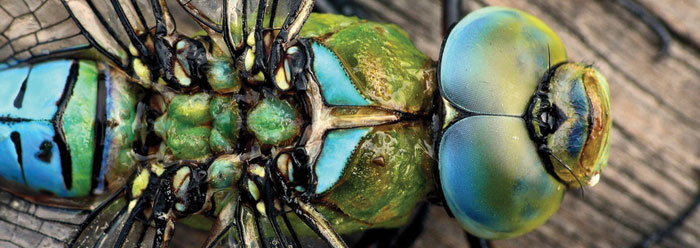Dragonflies dart with exceeding dexterity as they avoid obstacles and prey on other flying insects. This is made possible by the accuracy with which their eyes allow them to perceive their surroundings.
In fact, arthropods such as dragonflies and shrimp have some of the best optical equipment in the known world.1 If these advanced visual systems resulted from millions of years of evolutionary trial and error, one would expect to see a progression of simple-to-complicated eyes in fossils ascending earth's rock layers. But fully formed, advanced compound eyes have now been discovered on Australia's Kangaroo Island among Cambrian fossils…far too early to fit the evolutionary story.
The eye fossils featured tiny indentations that exactly matched the small surface features of many modern arthropod compound eyes. They were found in a gray mudstone and not attached to any bodies, but they looked very much like shrimp eyes. Compound eyes such as these contain many rows of individual wedge-shaped units called ommatidia, each with its own lens. In a report published in Nature, the study authors said, "The lenses are not only very numerous and large, they are also hexagonally arranged in a highly regular six-neighbour arrangement: the densest and most efficient packing pattern."2
A University of Adelaide online video described the Cambrian compound eye as "surprisingly advanced in many respects. It shows that primitive creatures rapidly evolved powerful vision during the 'Cambrian explosion.'"3 This "explosion" refers to the sudden appearance of representatives from every single animal phylum…alive or extinct…in the lowermost fossil-bearing Cambrian rocks, which evolutionists insist were deposited over 500 million years ago. But is "rapid evolution" really what this fossil shows?
The fossil compound eye the researchers examined, the most advanced yet discovered in Cambrian fossils, had over 3,000 lenses. It was compared, both in a University of Adelaide press release4 and the accompanying video, with the eyes of robber fly insects, which have excellent motion-detecting vision that enables them to hunt in flight.
The study authors wrote:
The new fossils reveal that some of the earliest arthropods had already acquired visual systems similar to those of living forms, underscoring the speed and magnitude of the evolutionary innovation that occurred during the Cambrian Explosion.2
Strict scientific observation, however, only shows that these lowermost arthropod fossils possessed fully developed eyes that were just as well-constructed as those of today's living arthropods. Statements about "earliest arthropods" and "evolutionary innovation" are not scientific, because they are derived directly from an evolutionary view of the world and of history…not from fossil data.
This advanced eye technology could never have been produced without an intelligent Creator. Technical designs only come from technical designers.
But even if these eyes could somehow have been randomly specified, there is not enough time within the evolutionary historical scheme for them to have developed. Supposedly, evolution innovated the compound eyes in a mere 30 million years, from the time life supposedly began evolving 542 million years ago to the time assigned to this compound eye fossil: 512 million years.
Reams of genetic information are required to construct compound eyes like those found in these fossils, and each bit of genetic information is supposed to have been generated by a lucky mutation. The problem is that according to the calculations performed by evolutionary researchers, 216 million years are needed to acquire just two coordinated mutations in sequence, at least in humans.5 Compound eyes needed thousands of coordinated mutations to have occurred in only 30 million years. In essence, evolutionists have refuted their own story.
The assertion that these eyes are the result of "evolutionary innovation" is clearly false. The alternative is that they were created. Advanced eyes in Cambrian fossils are no surprise to Bible-believers, who understand that God made shrimp with fully formed eyes from the beginning.
References
- Thomas, B. Shrimp Eye May Inspire New DVD Technology. ICR News. Posted on icr.org November 4, 2009, accessed July 6, 2011.
- Lee, M. S. Y. et al. 2011. Modern optics in exceptionally preserved eyes of Early Cambrian arthropods from Australia. Nature. 474 (7353): 631-634.
- New Fossils Demonstrate That Powerful Eyes Evolved in a Twinkling. The University of Adelaide online video. Posted on YouTube.com June 28, 2011, accessed July 6, 2011.
- New fossils provide evidence of powerful eyes. University of Adelaide press release, June 30, 2011.
- Durrett, R. and D. Schmidt. 2008. Waiting for Two Mutations: With Applications to Regulatory Sequence Evolution and the Limits of Darwinian Evolution. Genetics. 180 (3): 1501-1509.
* Mr. Thomas is Science Writer at the Institute for Creation Research.
Article posted on July 20, 2011.



















